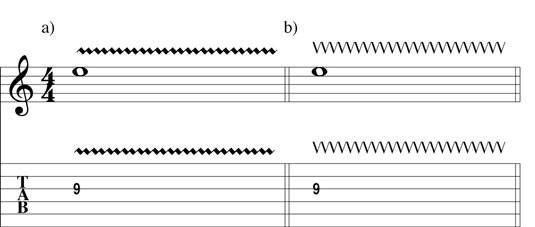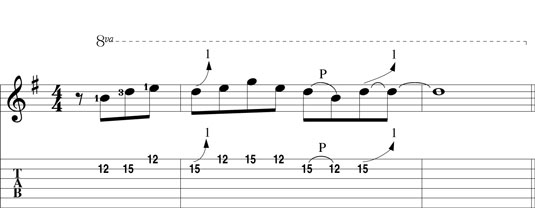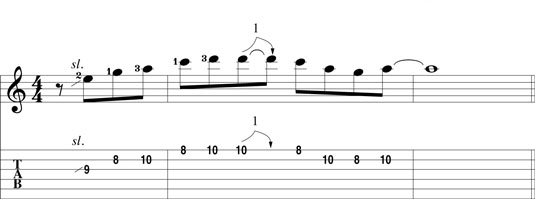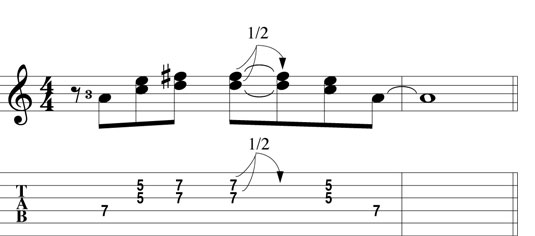Think of the term vibrato, and you may imagine a singer’s wavering voice or a violinist’s twitching hand. On the guitar, however, vibrato is a steady and usually slight fluctuation of pitch, most often achieved by rapidly bending and releasing a note a slight degree. A vibrato can add warmth, emotion, and life to a sustained note.
The best time to apply vibrato is whenever you hold a note for a long time. That’s when you can add some emotion to the note. Vibrato not only gives the note more warmth, but it also increases the sustain period of the note. Some guitarists, such as blues great B.B. King, are renowned for their expressive vibrato technique. Both the tab and standard notation indicate a vibrato by placing a wavy line at the top of the staff over the note to which you apply the technique.
You can produce a vibrato in several ways:
You can slightly bend and release a note over and over again, creating a wah-wah-wah effect. The left-hand technique for this method is the same as the technique for bending — move a finger back and forth, perpendicular to the string, creating a fluctuation of pitch. The average pitch of this type of vibrato is slightly higher than the unaltered note.
You can very rapidly slide your finger back and forth along the length of a string, within one fret. The pitch becomes slightly sharper as you move toward the nut and slightly flatter as you move toward the bridge. Consequently, the average pitch of the vibrato is the same as the unaltered note. This type of vibrato is reserved almost exclusively for playing classical guitar with nylon strings.
If your electric guitar has a whammy bar mounted on it, you can move the bar up and down with your right hand, creating a fluctuation in pitch. In addition to giving you greater rhythmic flexibility and pitch range, the whammy bar enables you to add vibrato to an open string.
The most common type of vibrato is the bend-and-release type (which is the first type of vibrato in the preceding list). To play this type of vibrato, support your vibrato finger with other available fingers by placing them all on the string at the same time. You can move your whole hand by rotating it at the wrist and keeping the finger fixed, or you can move just your finger(s). Try both ways and see which feels most comfortable.
You may find that playing a vibrato is easier if you anchor your left hand on the neck as you play. Squeeze the neck a little between the side of your thumb and the part of your palm that’s about half an inch below your first finger. This action gives you better leverage and helps you control the evenness of the fluctuation.
The following figure shows a vibrato at the ninth fret of the 3rd string. Anchor your hand and slightly bend and release the note over and over. Try the vibrato with each finger. Try it at different frets and on different strings.

The notation for a vibrato never tells you how quickly or slowly to bend and release — that’s up to you. But regardless of your speed, make sure that you keep the fluctuations steady and even. The notation does tell you, however, whether to make the vibrato narrow (that is, you bend the string only slightly — less than a half step — for each pulsation) or wide (you bend the string to a greater degree — about a half step or more).
In the preceding figure, the a) measure shows a regular (narrow) vibrato, and the b) measure shows a wide vibrato, as indicated by the exaggerated wavy line (with deeper peaks and valleys). Try playing a wide vibrato with each finger. Try it at different frets and on different strings.
If the note that you’re holding is a bent note, create the vibrato by releasing and bending (instead of bending and releasing) — because the note’s already bent as you start the vibrato, which makes the average pitch lower than the bent note, which itself produces the highest pitch in the vibrato.
To practice playing vibratos, play the examples in the following figures, but add a vibrato to the final note of each figure. Be careful with the first figure — the last note here is already bent, so you need to unbend (release) and bend the note to produce the vibrato. If you want, finish off each vibrato with a little slide-off.

The "8va" in the above music means that the notes are played an octave (12 half-steps) above where they are written. That's only necessary in the musical notation; just play the tab as it's written, and you'll already be playing in that upper octave.

Because they use no open strings, you can also move these fingering patterns around to different places on the neck so you can get a feel for adding vibrato in different places.

After a long vibrato, guitarists often play a descending slide, gradually releasing finger pressure as they go, to give the vibrato a fancy little ending. Another trick is to play a long note without vibrato for a while and then add some vibrato toward the end of the note. This “delayed vibrato” is a favorite technique that singers often use.

